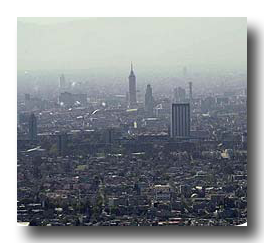
Science Objectives
Quantify:
- Geographical extent and temporal persistence of the urban plume:
- First characterization of regional air quality
- Comparisons to background air
- Unique chemical signatures?
- Regional oxidants production:
- O3, peroxides, acids, radicals
- Alterations of photochemistry by aerosol heterogeneous and radiative processes
- Hydrocarbon oxidation products:
- Evolution of long-lived intermediates, e.g. acetone
- Impacts on regional HOx and NOx partitioning and budgets
- Secondary organic aerosol formation
- Removal mechanisms
- Reactive nitrogen:
- Lifetime of NOx
- Differential fate of reservoirs:
- HNO3-soluble, sensitive to aerosols and clouds
- PANs-thermally decomposed, sensitive to temperature
- Alkyl nitrates - long-lived, potentially important to global NOx
- Gas-aerosol chemical processes:
- New particle formation
- Condensation from gas phase
- Oxidation
- Microphysical properties, effects on clouds
- Feedbacks on gas phase (removal, photolysis)
- Aerosol radiative properties:
- Evolution of optical properties, absorption vs. scattering
- Internal vs. external mixture
- Vertical radiation profiles
- Regional surface-atmosphere interactions:
- Background air composition
- Urban plume + fire emissions
- Urban plume + biogenic emissions
Reasons to Study Mexico City Outflow:

- Size: ~20 million population, one of the world's highest
- Economy: Emission characteristics intermediate between cities in emerging and
developed economies.
- Representative: Mature megacity, with evolving emissions and regulations.
Possible model for future development of other megacities
- Tropical location: As for most fast growing megacities.
- Abundant sunshine: Rapid photochemical development can be studied in hours/days,
rather than days/weeks.
- Signal strength: Very strong urban source surrounded by an only moderately
polluted region.
- Emissions Inventories: Are already available or in development.
- Urban air quality monitoring: Over a decade of continuous measurements (NOx, O3,
CO, SO2, PM).
- Previous urban studies: Experimental and modeling studies: photochemistry,
aerosols (chemical & physical properties), surface radiation (visible, UV), boundary
layer evolution and regional-scale diurnal circulations.
- Collaborations possible: local laboratories (university, government, industrial)
conduct air quality research.
- Good logistics & infrastructure: essential for an intensive measurement campaign
with aircraft.

